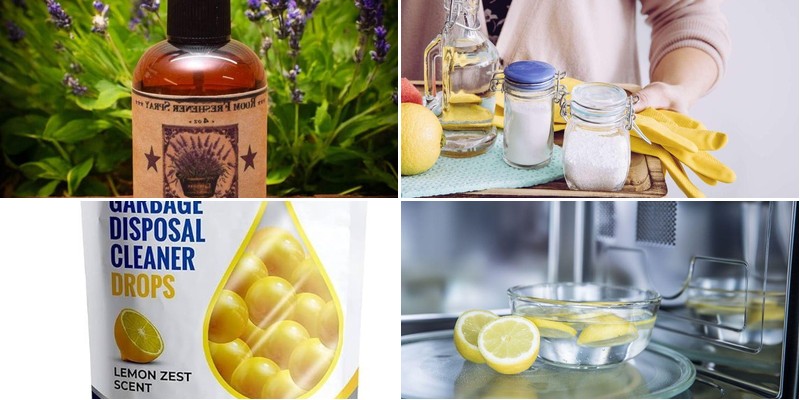Just imagine transforming your home into a sparkling, chemical-free sanctuary using simple ingredients from your pantry! We’ve gathered 20 brilliant natural cleaning recipes that are easy, effective, and wonderfully eco-friendly. From citrus-infused all-purpose sprays to baking soda scrubs that work wonders, these DIY solutions will revolutionize your cleaning routine. Get ready to discover how simple it can be to create a healthier, greener home—let’s dive in!
Lemon and Baking Soda Sink Scrub
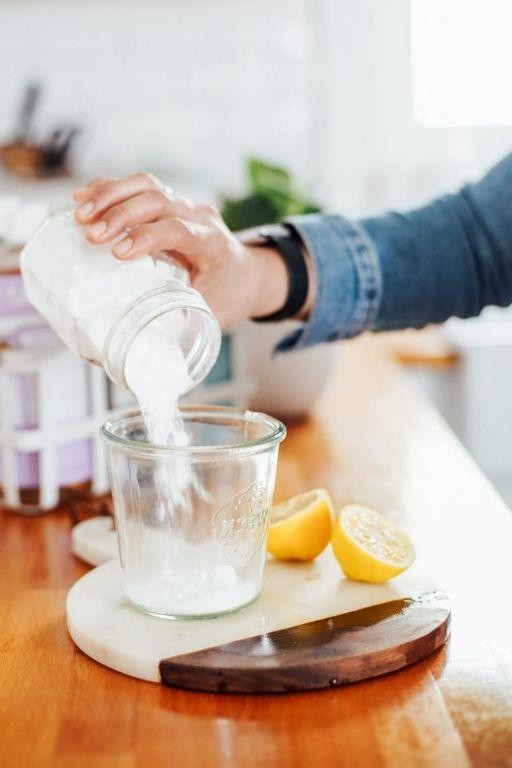
Diligent home cooks know that sometimes the simplest ingredients create the most effective solutions. This lemon and baking soda sink scrub combines two pantry staples to tackle stubborn stains and leave your sink sparkling with a fresh citrus scent. Follow these precise steps to create a powerful, natural cleaning paste that requires minimal effort for maximum results.
1
batch10
minutesIngredients
- 1/2 cup baking soda
- 1 fresh lemon, juiced (approximately 3 tablespoons)
- 1 tablespoon distilled white vinegar
- 1 teaspoon coarse sea salt
Instructions
- Measure exactly 1/2 cup of baking soda into a medium glass mixing bowl.
- Cut the fresh lemon in half crosswise and squeeze both halves using a citrus juicer to extract approximately 3 tablespoons of fresh lemon juice.
- Gradually pour the fresh lemon juice into the baking soda while stirring continuously with a wooden spoon until a thick paste forms. Tip: The mixture will fizz slightly as the acid reacts with the baking soda – this is normal and indicates the cleaning agents are activating.
- Add 1 tablespoon of distilled white vinegar to the mixture and incorporate thoroughly until the paste becomes smooth and spreadable.
- Mix in 1 teaspoon of coarse sea salt, which provides gentle abrasion for tackling tough stains without scratching surfaces.
- Apply the scrub directly to your dry sink surface using a clean cloth or sponge, working in small circular sections of approximately 6×6 inches.
- Let the scrub sit on the sink surface for exactly 5 minutes to allow the chemical reaction to break down stains and grime. Tip: For heavily stained areas, extend the sitting time to 8-10 minutes for enhanced cleaning power.
- Scrub the entire sink surface using firm, circular motions with a non-abrasive scrub pad, paying extra attention to stained areas and drain edges.
- Rinse thoroughly with warm water at 110°F, ensuring all residue is completely washed away. Tip: Use a clean microfiber cloth to wipe down the sink after rinsing for a streak-free finish and enhanced shine.
- Dry the sink completely with a clean, lint-free towel to prevent water spots and maintain the polished appearance.
Beyond just cleaning, this scrub leaves your sink with a brilliant shine and subtle citrus fragrance that lingers pleasantly. The fine abrasive texture effectively removes stubborn water marks while being gentle enough for daily use on stainless steel surfaces. Consider keeping a small batch in an airtight container for quick touch-ups between deep cleanings.
Vinegar-Based All-Purpose Cleaner

For those seeking an effective, natural cleaning solution, this vinegar-based cleaner combines simple ingredients into a powerful formula that tackles household grime with professional results. Following these precise steps will yield a versatile cleaner perfect for daily use around your home.
1
bottles5
minutesIngredients
- 2 cups distilled white vinegar
- 1 cup filtered water
- 15 drops pure lemon essential oil
- 10 drops tea tree essential oil
Instructions
- Select a 32-ounce glass spray bottle with a fine-mist trigger mechanism for optimal application.
- Measure exactly 2 cups of distilled white vinegar using a liquid measuring cup with clear measurement markings.
- Pour the measured vinegar directly into the clean glass spray bottle, ensuring no spillage occurs.
- Measure precisely 1 cup of filtered water at room temperature (68-72°F) using the same liquid measuring cup.
- Combine the filtered water with the vinegar in the spray bottle, creating the base solution.
- Securely fasten the spray bottle cap and shake vigorously for 30 seconds to thoroughly integrate the liquids.
- Uncap the bottle and carefully add 15 drops of pure lemon essential oil using the built-in dropper.
- Immediately add 10 drops of tea tree essential oil directly into the solution without touching the bottle rim.
- Replace the cap tightly and shake the mixture energetically for 45 seconds until the oils are fully emulsified.
- Allow the solution to rest undisturbed for 24 hours at room temperature to achieve complete integration.
Many homemade cleaners develop a cloudy appearance, but this formula maintains crystal clarity with a refreshing citrus aroma that lingers pleasantly. The balanced acidity cuts through grease effectively while the essential oils provide natural antibacterial properties, making it ideal for kitchen surfaces and bathroom fixtures alike.
Essential Oil Disinfectant Spray

Let’s create a powerful, natural disinfectant spray using essential oils, perfect for keeping your kitchen surfaces clean and fresh. This methodical approach ensures you’ll achieve maximum antimicrobial effectiveness while filling your space with a pleasant, non-toxic aroma. Following these precise steps will result in a professional-grade cleaning solution that’s both effective and environmentally conscious.
1
bottle5
minutesIngredients
– 1 cup distilled water
– 1/2 cup 70% isopropyl alcohol
– 20 drops tea tree essential oil
– 15 drops lemon essential oil
– 10 drops lavender essential oil
– 8-ounce amber glass spray bottle
Instructions
1. Sanitize your 8-ounce amber glass spray bottle by washing it with hot, soapy water and allowing it to air dry completely.
2. Measure exactly 1/2 cup of 70% isopropyl alcohol and pour it into the clean spray bottle.
3. Add 20 drops of tea tree essential oil to the alcohol mixture, counting each drop carefully for precise measurement.
4. Incorporate 15 drops of lemon essential oil into the solution, ensuring the citrus notes will provide both cleaning power and fresh scent.
5. Add 10 drops of lavender essential oil to complete the essential oil blend, creating a balanced aromatic profile.
6. Gently swirl the bottle for 30 seconds to combine the essential oils with the alcohol base, being careful not to shake vigorously to prevent excessive foaming.
7. Pour exactly 1 cup of distilled water into the mixture, using filtered water to prevent mineral deposits that could clog the spray mechanism.
8. Securely fasten the spray bottle lid and shake the mixture vigorously for 45 seconds until all ingredients are fully emulsified.
9. Label the bottle clearly with the contents and date of creation for proper tracking of freshness and potency.
10. Store the completed disinfectant spray in a cool, dark place away from direct sunlight to preserve the essential oils’ antimicrobial properties.
This disinfectant spray creates a fine, even mist that clings to surfaces without streaking, allowing the antimicrobial properties to work effectively. The finished product delivers a refreshing herbal-citrus aroma that eliminates odors rather than masking them. Consider using this versatile spray not just for kitchen counters but also for disinfecting cutting boards, refrigerator handles, and other high-touch areas throughout your home.
Natural Floor Cleaner with White Vinegar
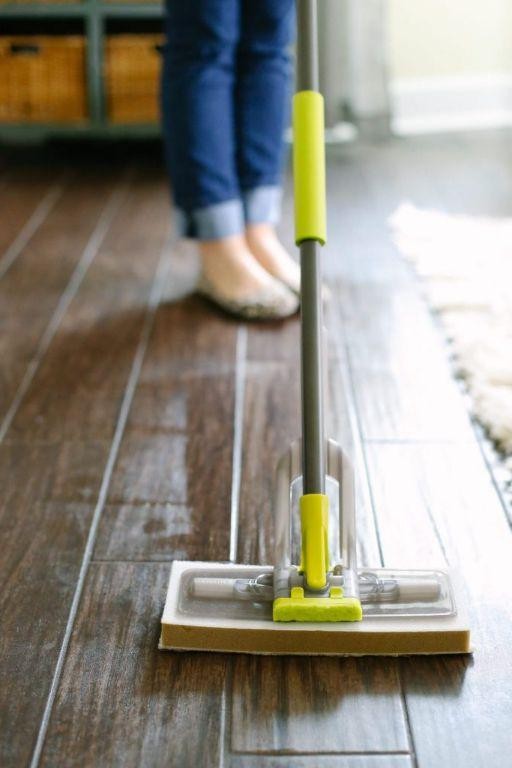
Venturing into natural cleaning solutions can transform your home maintenance routine while being gentle on both surfaces and the environment. This straightforward floor cleaner harnesses the power of simple ingredients to deliver sparkling results without harsh chemicals, making it perfect for regular use on sealed hard surfaces.
1
batch5
minutesIngredients
- 1 cup distilled white vinegar
- 1 gallon filtered water
- 15 drops pure lemon essential oil
Instructions
- Combine 1 cup of distilled white vinegar with 1 gallon of filtered water in a clean plastic bucket.
- Add 15 drops of pure lemon essential oil to the vinegar-water mixture.
- Stir the solution vigorously with a long-handled wooden spoon for 30 seconds to ensure complete integration.
- Dip a microfiber mop into the cleaning solution, then wring it firmly until damp but not dripping.
- Begin mopping from the farthest corner of the room, working in 3-foot sections toward the exit.
- Overlap each stroke by 2 inches to prevent streaking and ensure complete coverage.
- Allow the solution to remain on the floor surface for exactly 2 minutes before drying.
- Use a dry microfiber cloth to wipe the floor in the direction of the wood grain or tile pattern.
- Rinse the mop head thoroughly in clean water after completing each 100 square feet of flooring.
Freshly cleaned surfaces will exhibit a subtle citrus aroma that dissipates within minutes, leaving behind no chemical residue. For enhanced cleaning power on heavily soiled areas, consider applying the solution with a spray bottle before mopping. The finished floors will display a natural shine that highlights the true character of your flooring material without any waxy buildup.
Homemade Glass Cleaner with Cornstarch
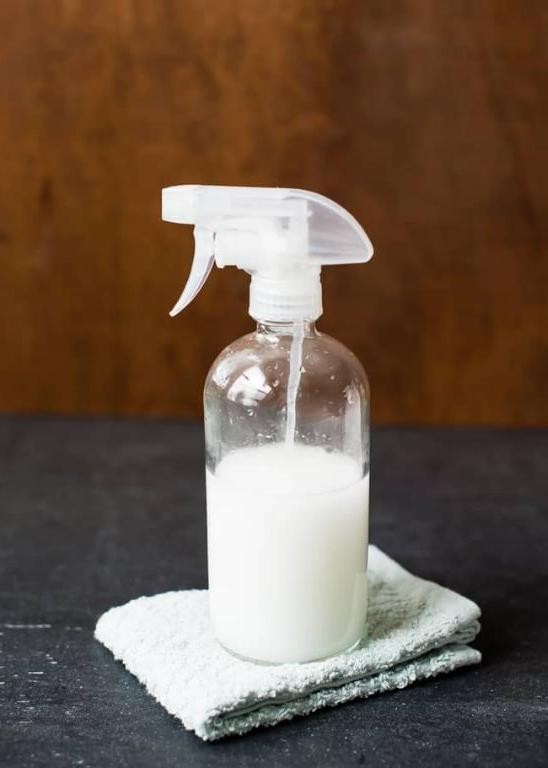
Looking for a streak-free shine without harsh chemicals? Let’s create a homemade glass cleaner that leaves your windows crystal clear using simple kitchen ingredients. This cornstarch-based formula provides professional-level results with minimal effort.
1
bottle10
minutes4
minutesIngredients
- 1/2 cup distilled white vinegar
- 1/4 cup 70% isopropyl alcohol
- 2 tablespoons food-grade cornstarch
- 2 cups filtered water
- 10 drops pure lemon essential oil
Instructions
- Combine 2 cups filtered water and 2 tablespoons food-grade cornstarch in a medium saucepan.
- Whisk the mixture continuously over medium heat until it reaches 180°F and thickens to a milky consistency, about 3-4 minutes.
- Remove the saucepan from heat and let the cornstarch slurry cool to room temperature, approximately 20 minutes.
- Pour 1/2 cup distilled white vinegar into a 24-ounce glass spray bottle using a funnel.
- Add 1/4 cup 70% isopropyl alcohol to the same bottle.
- Transfer the completely cooled cornstarch slurry into the spray bottle.
- Add 10 drops pure lemon essential oil to the mixture.
- Secure the spray bottle lid tightly and shake vigorously for 30 seconds until all ingredients are fully emulsified.
- Label the bottle with contents and date using a permanent marker.
- Shake the bottle thoroughly before each use to redistribute the cornstarch.
- Spray the cleaner onto glass surfaces from 6-8 inches away in a sweeping motion.
- Wipe immediately with a microfiber cloth using horizontal strokes on one side and vertical strokes on the reverse.
Gently buffed surfaces reveal an invisible, streak-free finish that repels dust and fingerprints. The cornstarch creates a protective barrier while the lemon oil leaves behind a fresh, clean scent. Try using this formula on mirrors, picture frames, or even glass tabletops for consistently brilliant results throughout your home.
Natural Wood Polish with Olive Oil
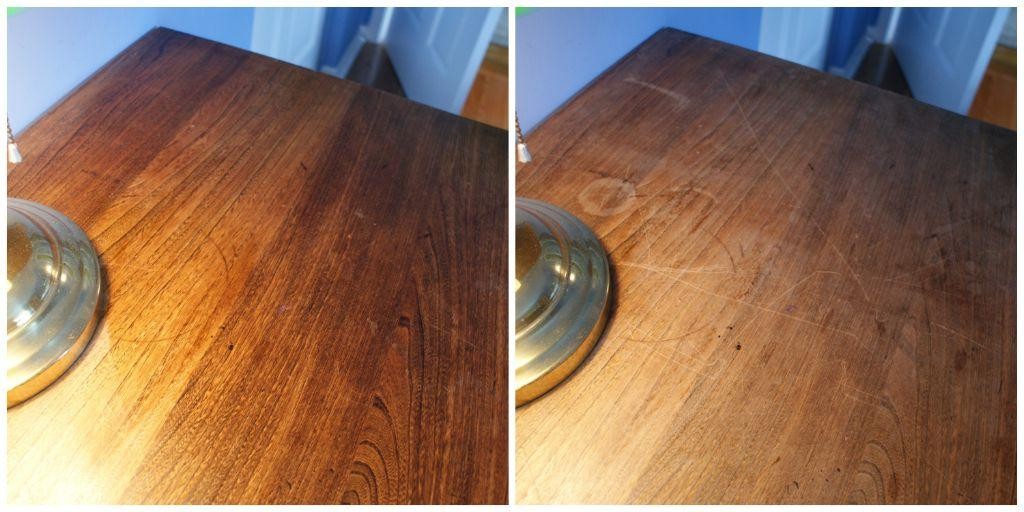
A surprisingly simple yet effective way to restore luster to your wooden surfaces, this natural polish combines pantry staples for a chemical-free shine. Applying this homemade blend requires minimal effort but yields professional-looking results that protect and enhance your wood’s natural grain. Follow these methodical steps to create a polish that leaves your furniture glowing with health and vitality.
1
batch5
minutesIngredients
– 1/2 cup extra virgin olive oil
– 1/4 cup white vinegar
– 15 drops lemon essential oil
Instructions
1. Combine 1/2 cup extra virgin olive oil and 1/4 cup white vinegar in a glass measuring cup.
2. Whisk the mixture vigorously for 30 seconds until fully emulsified.
3. Add 15 drops of lemon essential oil to the emulsified base.
4. Stir gently with a wooden spoon to incorporate the essential oil evenly.
5. Transfer the finished polish to a clean glass jar with a tight-fitting lid.
6. Label the jar with the date and contents using a permanent marker.
7. Test the polish on an inconspicuous area of your wood surface first.
8. Shake the jar vigorously for 15 seconds before each use to re-emulsify.
9. Pour a small amount of polish onto a clean, lint-free cotton cloth.
10. Apply the polish to your wood surface using long, even strokes following the wood grain.
11. Allow the polish to penetrate the wood for exactly 5 minutes.
12. Buff the surface with a separate dry cloth using firm, circular motions.
13. Continue buffing until no visible residue remains and the surface feels smooth.
14. Store any unused polish in a cool, dark place away from direct sunlight.
Creating this polish results in a smooth, non-greasy finish that enhances wood’s natural beauty without artificial buildup. The subtle citrus aroma from the essential oil provides a fresh, clean scent that lingers pleasantly in your space. Consider using this polish on cutting boards and wooden utensils for both maintenance and food-safe protection.
DIY Toilet Bowl Cleaner with Citric Acid

Every household needs effective cleaning solutions, and this DIY toilet bowl cleaner combines natural ingredients with professional-grade cleaning power. Let’s create a sparkling clean bathroom using simple chemistry and precise measurements.
1
batch10
minutesIngredients
– 1 cup food-grade citric acid crystals
– ½ cup filtered water at 120°F
– 15 drops pure peppermint essential oil
– 2 tablespoons vegetable-based liquid castile soap
Instructions
1. Measure 1 cup of food-grade citric acid crystals into a heat-safe glass mixing bowl.
2. Heat ½ cup of filtered water to exactly 120°F using a digital thermometer.
3. Slowly pour the heated water into the citric acid crystals while whisking continuously with a stainless steel whisk.
4. Continue whisking for 2 minutes until the mixture forms a smooth, thick paste without visible crystals.
5. Add 2 tablespoons of vegetable-based liquid castile soap to the mixture.
6. Incorporate 15 drops of pure peppermint essential oil using a glass dropper.
7. Mix thoroughly for 1 minute until all ingredients are completely emulsified.
8. Transfer the mixture to a clean, dry glass jar with an airtight lid.
9. Label the jar with the date and contents using a permanent marker.
10. Store the cleaner in a cool, dark place away from direct sunlight for 24 hours to allow proper setting.
11. Apply 2 tablespoons of the cleaner directly under the rim of a dry toilet bowl.
12. Let the cleaner sit undisturbed for 30 minutes to break down mineral deposits.
13. Scrub the bowl thoroughly with a toilet brush for 2 minutes, paying special attention to stained areas.
14. Flush the toilet to rinse away all residue.
15. Wipe the exterior of the bowl with a clean cloth to remove any splashes.
Making this cleaner creates a thick, scoopable paste that clings to vertical surfaces without dripping. The peppermint oil provides a fresh, invigorating scent while the citric acid effectively dissolves stubborn lime scale. For extra cleaning power, apply the paste before bedtime and let it work overnight.
Baking Soda and Vinegar Drain Cleaner

Ever find yourself with a sluggish kitchen drain and no commercial cleaner on hand? This simple two-ingredient solution uses basic pantry staples to tackle minor clogs effectively. Let’s walk through the process methodically to restore your drain’s flow.
1
drain5
minutesIngredients
– 1/2 cup baking soda
– 1 cup white vinegar
– 4 cups boiling water (212°F)
Instructions
1. Pour 1/2 cup of baking soda directly down the drain opening.
2. Immediately follow with 1 cup of white vinegar, pouring it slowly to maximize the chemical reaction.
3. Cover the drain opening with a plug or cloth to contain the fizzing action for 15 minutes. Tip: The bubbling reaction helps break down organic matter and grease buildup.
4. While waiting, bring 4 cups of water to a rolling boil at 212°F.
5. After 15 minutes have elapsed, carefully pour the boiling water down the drain in a steady stream. Tip: The hot water helps flush away dissolved debris and residual baking soda.
6. Allow the drain to sit undisturbed for 5 minutes to ensure complete drainage.
7. Test water flow by running cold tap water for 30 seconds. Tip: For stubborn clogs, repeat the entire process after allowing the pipes to cool completely.
After treatment, your drain should demonstrate improved water flow with reduced gurgling sounds. The chemical reaction leaves pipes feeling refreshed without harsh chemical residues. Consider using this method monthly as preventative maintenance to keep drains clear and odor-free.
Lemon and Salt Microwave Cleaner
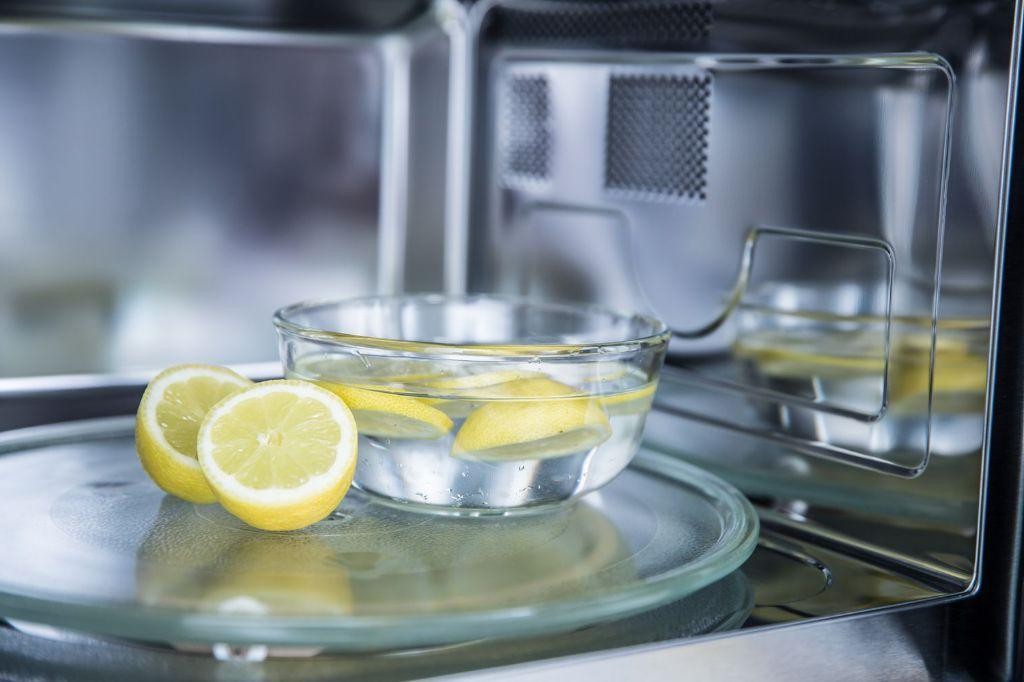
Just when you think your microwave needs professional cleaning, this simple kitchen hack will restore it to sparkling condition with ingredients you already have on hand. Join me as we walk through this surprisingly effective cleaning method that requires no harsh chemicals or scrubbing. You’ll be amazed at how easily stubborn food splatters dissolve away.
1
microwave2
minutes5
minutesIngredients
– 1 cup filtered water
– 2 tablespoons freshly squeezed lemon juice
– 1 tablespoon fine sea salt
Instructions
1. Combine 1 cup filtered water, 2 tablespoons freshly squeezed lemon juice, and 1 tablespoon fine sea salt in a microwave-safe glass bowl.
2. Place the bowl in the center of your microwave oven and heat on high power for 5 minutes, or until the liquid reaches a rolling boil.
3. Allow the steaming bowl to remain in the closed microwave for 10 minutes to let the lemon-salt steam penetrate and loosen baked-on grime.
4. Carefully remove the hot bowl using oven mitts, as the glass will be extremely hot to the touch.
5. Dip a clean microfiber cloth into the warm lemon-salt solution and wring out excess liquid until damp but not dripping.
6. Wipe the interior surfaces of the microwave thoroughly, paying special attention to corners and the ceiling where splatters accumulate.
7. For stubborn spots, sprinkle a small amount of additional fine sea salt directly onto the cloth to create extra abrasion without scratching surfaces.
8. Rinse the interior with a separate cloth dampened with clean water to remove any residual salt or lemon residue.
9. Dry all surfaces completely with a fresh microfiber cloth to prevent water spots and ensure a streak-free finish.
Remarkably, this method leaves your microwave not only visually clean but also smelling fresh and citrusy. The combination creates a gentle yet effective cleaning solution that cuts through grease without damaging surfaces. Consider using this technique monthly as part of your regular kitchen maintenance routine to keep your microwave in pristine condition.
Herbal Air Freshener with Lavender
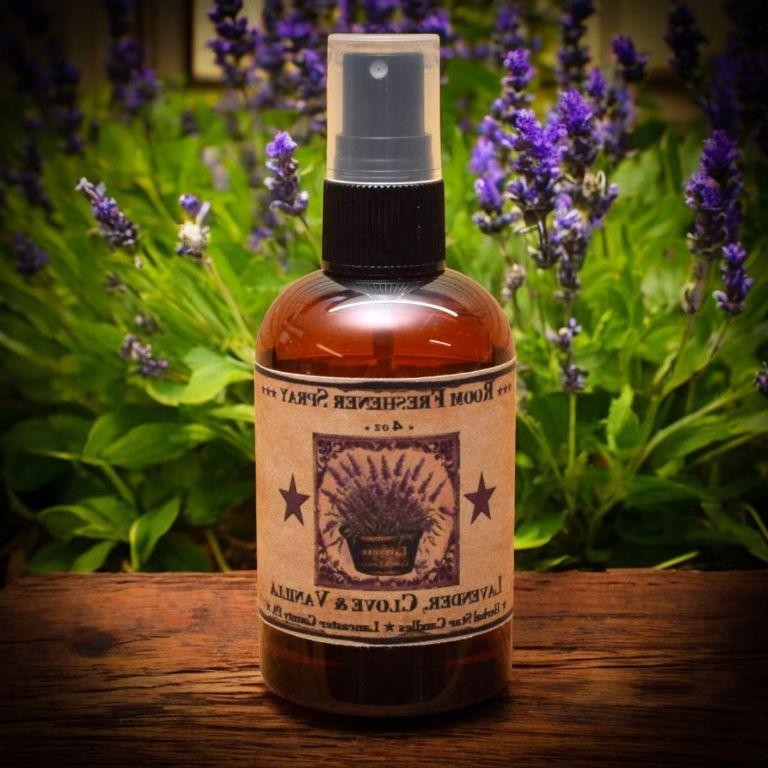
Now, let’s create a natural air freshener that will transform your home into a serene sanctuary using simple herbal ingredients. This lavender-infused spray combines botanical elegance with practical functionality, perfect for those seeking chemical-free home fragrance solutions. We’ll methodically craft this aromatic blend using precise measurements and techniques.
1
bottle20
minutesIngredients
- 1 cup distilled water
- 2 tablespoons dried culinary-grade lavender buds
- 1 tablespoon high-proof vodka (at least 80 proof)
- 15 drops pure lavender essential oil
- 5 drops organic lemon essential oil
Instructions
- Place 2 tablespoons of dried culinary-grade lavender buds into a heatproof glass measuring cup.
- Bring 1 cup of distilled water to exactly 180°F using a digital thermometer to monitor temperature.
- Pour the heated distilled water over the lavender buds, ensuring complete saturation.
- Steep the lavender infusion for precisely 15 minutes, covered with a ceramic plate to retain aromatic compounds.
- Strain the lavender infusion through a fine-mesh sieve lined with unbleached cheesecloth into a clean glass bowl.
- Add 1 tablespoon of high-proof vodka to the strained infusion, which acts as both preservative and solvent for essential oils.
- Measure 15 drops of pure lavender essential oil directly into the mixture using a glass dropper for accuracy.
- Add 5 drops of organic lemon essential oil to brighten the floral notes and enhance freshness.
- Transfer the completed herbal air freshener to an 8-ounce amber glass spray bottle using a stainless steel funnel.
- Shake the bottle vigorously for 30 seconds to fully emulsify the oils with the water base.
Lavender’s calming floral notes blend beautifully with the citrus brightness in this sophisticated air freshener. The mist delivers a delicate, non-overpowering fragrance that lingers subtly in any room. For creative application, spritz lightly over linens before bed or use as a natural car freshener during warm weather months.
DIY Dish Soap with Castile Soap
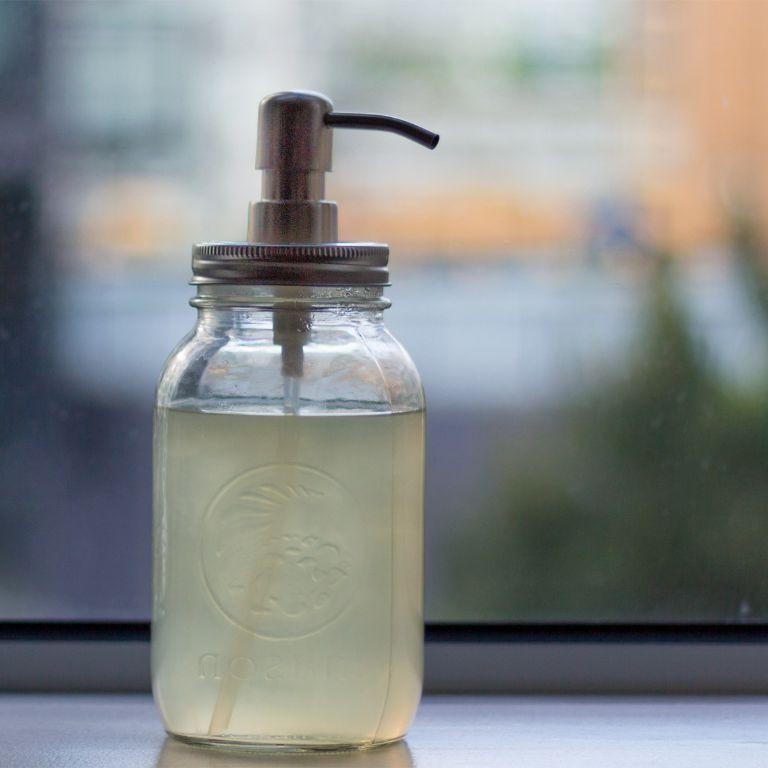
Tackling household cleaning doesn’t require harsh chemicals when you can create your own effective dish soap. This DIY version using pure castile soap offers a gentle yet powerful clean for your dishes while being kind to your hands and the environment. Let’s walk through the simple process together, ensuring you achieve the perfect consistency for daily use.
Ingredients
- 1 cup unscented liquid castile soap
- 2 tablespoons food-grade vegetable glycerin
- 15 drops pure lemon essential oil
- 5 drops pure tea tree essential oil
- 3/4 cup distilled water, heated to 120°F
Instructions
- Measure 1 cup of unscented liquid castile soap into a clean glass mixing bowl.
- Add 2 tablespoons of food-grade vegetable glycerin to the castile soap, stirring gently with a silicone spatula until fully incorporated. Tip: Glycerin helps maintain moisture in your hands during washing.
- Combine 15 drops of pure lemon essential oil and 5 drops of pure tea tree essential oil into the mixture, stirring for 30 seconds to ensure even distribution.
- Heat 3/4 cup of distilled water to exactly 120°F using a digital thermometer.
- Slowly pour the heated distilled water into the soap mixture while continuously whisking with a wire whisk. Tip: Warm water helps ingredients emulsify more effectively.
- Whisk the mixture vigorously for 2 full minutes until it reaches a uniform, slightly thickened consistency.
- Transfer the completed dish soap into a clean plastic squeeze bottle using a funnel. Tip: Label your bottle with the date to track freshness.
- Secure the bottle cap tightly and shake gently for 15 seconds to finalize the emulsion.
Perfectly balanced between cleaning power and skin gentleness, this homemade soap creates rich suds that cut through grease without leaving residue. The bright citrus scent from lemon oil pairs beautifully with tea tree’s fresh clean aroma, making dishwashing feel more like a spa treatment than a chore. Consider keeping a decorative bottle by your kitchen sink to impress guests with your sustainable cleaning solution.
Green Window Cleaner with Tea Tree Oil
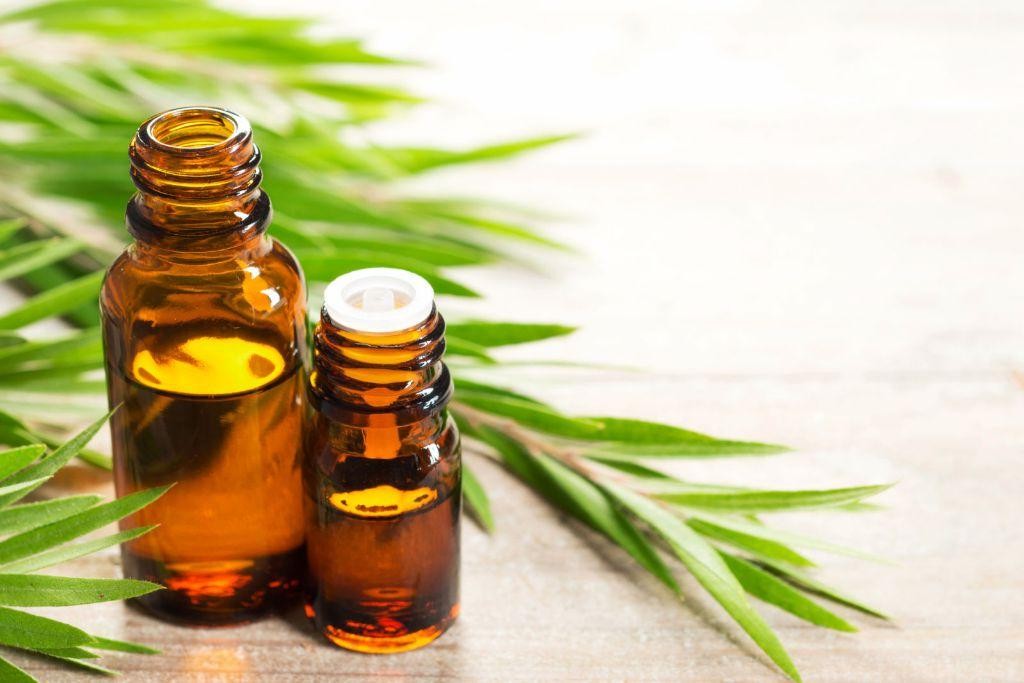
Creating this effective cleaning solution requires precision and the right ingredients to achieve that streak-free shine we all desire. Carefully follow each step to ensure optimal results for your window surfaces.
Ingredients
- 2 cups distilled white vinegar
- 1/2 cup 70% isopropyl alcohol
- 1 tablespoon pure tea tree essential oil
- 1 teaspoon vegetable-based liquid castile soap
- 2 cups filtered water
Instructions
- Combine 2 cups distilled white vinegar and 1/2 cup 70% isopropyl alcohol in a 32-ounce glass spray bottle.
- Add 1 tablespoon pure tea tree essential oil to the mixture, swirling gently to incorporate.
- Measure 1 teaspoon vegetable-based liquid castile soap and add it to the bottle.
- Pour in 2 cups filtered water, leaving 1 inch of headspace at the top.
- Securely fasten the spray nozzle and shake vigorously for 30 seconds until fully emulsified.
- Test the solution on a small, inconspicuous window area to check for compatibility with your surface.
- Spray the cleaner generously onto dry window glass from a distance of 6-8 inches.
- Allow the solution to dwell on the surface for exactly 60 seconds to break down grime.
- Wipe the window with a microfiber cloth using vertical strokes on one side and horizontal on the reverse for streak identification.
- Buff the surface with a clean, dry microfiber cloth until completely streak-free.
Expect exceptionally clear glass with the fresh, medicinal aroma of tea tree oil cutting through any lingering odors. The solution leaves behind no residue while providing natural antimicrobial protection. Consider storing this cleaner in a cool, dark place to maintain its efficacy between uses.
Simple Stainless Steel Cleaner
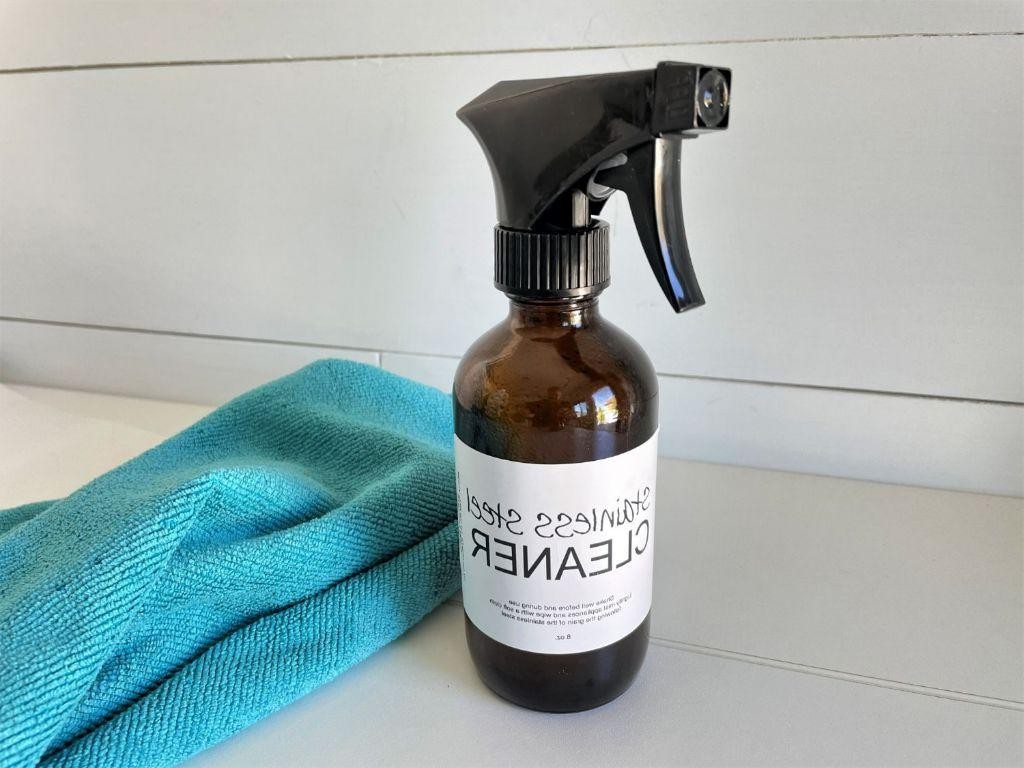
Cleaning stainless steel doesn’t have to involve harsh chemicals when you can create this effective homemade solution. Consider this simple cleaner your new go-to for maintaining that beautiful metallic shine throughout your kitchen, using ingredients you likely already have on hand.
1
batch5
minutesIngredients
– 1 cup distilled white vinegar
– 2 tablespoons extra virgin olive oil
– 1 tablespoon baking soda
– 4 cups filtered water
– 5 drops lemon essential oil
Instructions
1. Combine 1 cup distilled white vinegar and 4 cups filtered water in a 32-ounce glass spray bottle.
2. Add 1 tablespoon baking soda to the vinegar-water mixture and swirl gently until fully dissolved.
3. Incorporate 5 drops lemon essential oil into the solution for fresh scent and additional cleaning power.
4. Shake the bottle vigorously for 30 seconds to ensure all ingredients are thoroughly combined.
5. Spray the cleaning solution generously onto cool, dry stainless steel surfaces until evenly coated.
6. Allow the solution to sit on the surface for exactly 3 minutes to break down grime and water spots.
7. Wipe the surface with a soft microfiber cloth using straight, overlapping strokes following the metal’s grain.
8. Apply 2 tablespoons extra virgin olive oil to a separate clean microfiber cloth.
9. Buff the stainless steel surface with the oiled cloth using circular motions for 2 minutes until achieving a brilliant shine.
10. Remove any excess oil by wiping the surface once more with a dry microfiber cloth.
Notice how this cleaner leaves your stainless steel with a smooth, fingerprint-resistant finish that enhances its natural luster. The subtle citrus aroma from the lemon oil provides a fresh, clean scent without chemical undertones. For particularly stubborn spots, you might apply the solution twice, allowing the vinegar to work its magic on built-up residue.
Natural Fabric Softener with Eucalyptus
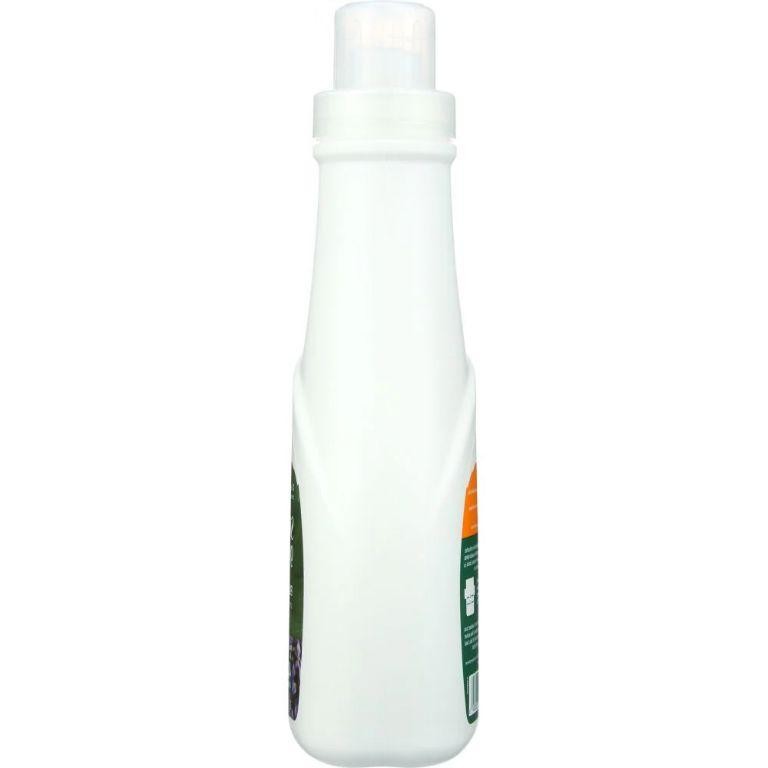
Saving money and reducing chemical exposure in your laundry routine can be surprisingly simple with this homemade alternative. This natural fabric softener harnesses the fresh, cleansing power of eucalyptus essential oil to leave your linens feeling soft and smelling wonderfully clean. Let’s walk through the straightforward process together, step by step, to create this effective household staple.
32
ounces5
minutesIngredients
– 2 cups distilled white vinegar
– 1 cup filtered water
– 30 drops pure eucalyptus essential oil
– 1 tablespoon vegetable glycerin
Instructions
1. Pour 2 cups of distilled white vinegar into a clean 32-ounce glass bottle with a tight-sealing lid.
2. Add 1 cup of filtered water to the bottle, using room temperature water to prevent any reaction with the glass.
3. Measure precisely 30 drops of pure eucalyptus essential oil directly into the vinegar-water mixture.
4. Incorporate 1 tablespoon of vegetable glycerin, which will help the oil blend evenly and prevent separation.
5. Securely fasten the bottle lid and shake vigorously for 45-60 seconds until the ingredients are fully emulsified.
6. Store the mixture in a cool, dark place for 24 hours to allow the eucalyptus oil to fully integrate with the base liquids.
7. Shake the bottle again for 30 seconds before each use to redistribute any settled ingredients.
8. Add 1/4 cup of the prepared fabric softener to your washing machine’s fabric softener dispenser during the final rinse cycle.
Keeping your laundry naturally fresh has never been easier with this homemade solution. The finished softener produces linens with a subtle, herbaceous fragrance that lingers without being overpowering. For an extra freshness boost, consider adding a few drops of lavender essential oil to create a custom botanical blend perfect for bedding and towels.
Citrus-Infused Garbage Disposal Cleaner
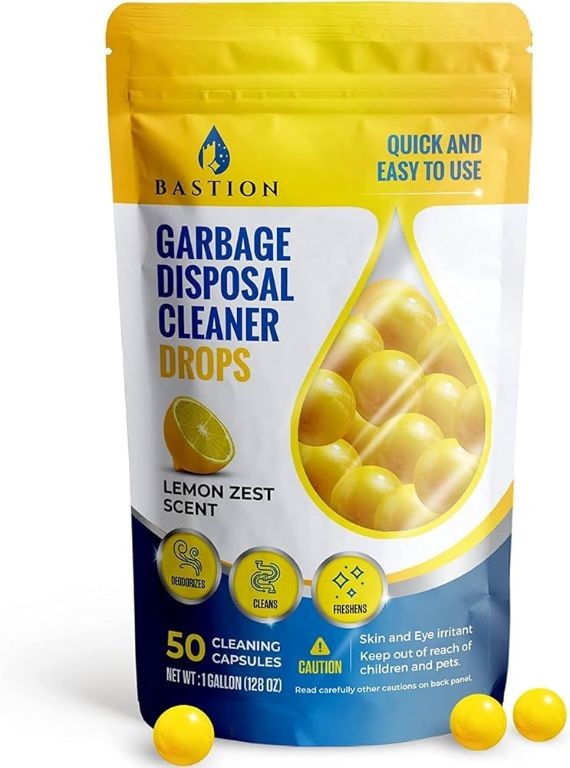
Just when you think your garbage disposal needs professional help, this citrus-infused cleaner will restore its freshness with simple kitchen ingredients. Join me as we methodically transform basic components into a powerful, natural cleaning solution that eliminates odors while being gentle on your plumbing system. This step-by-step approach ensures even beginners can achieve professional results with confidence.
2
portions10
minutesIngredients
– 1 cup coarse sea salt crystals
– 1/2 cup baking soda
– 1/2 cup distilled white vinegar
– Fresh citrus peels from 2 organic lemons
– 4-6 ice cubes made from filtered water
Instructions
1. Measure precisely 1 cup of coarse sea salt crystals into a medium glass mixing bowl.
2. Add exactly 1/2 cup of baking soda to the sea salt in the mixing bowl.
3. Using a silicone spatula, thoroughly combine the dry ingredients until uniformly distributed.
4. Zest 2 organic lemons using a microplane, collecting only the vibrant yellow outer peel.
5. Gently fold the fresh lemon zest into the dry mixture until evenly dispersed.
6. Transfer the completed dry cleaner to an airtight glass container for storage.
7. Remove any visible debris from your garbage disposal using kitchen tongs.
8. Pour 1/2 of the prepared dry cleaner mixture directly into the disposal opening.
9. Follow immediately with 1/2 cup of distilled white vinegar, watching the chemical reaction foam for exactly 30 seconds.
10. Place 4-6 filtered water ice cubes into the disposal chamber.
11. Turn on cold water at medium flow and run the disposal for 60 seconds until ice completely processes.
12. Repeat steps 8-11 with remaining cleaner mixture for thorough deodorization.
Maintain your disposal’s pristine condition with this dual-action cleaner that combines abrasive scrubbing power with natural citrus oils. The coarse salt crystals effectively scrub away residue while the lemon zest leaves behind a fresh, invigorating scent that permeates your entire kitchen. Consider storing extra portions in decorative jars as thoughtful housewarming gifts for fellow home cooks.
Conclusion
Revolutionize your cleaning routine with these simple, eco-friendly recipes! We hope this collection inspires you to create a healthier, greener home. Try a few recipes this weekend and let us know which ones become your favorites in the comments below. If you found this helpful, please share it on Pinterest to help others discover natural cleaning too!
